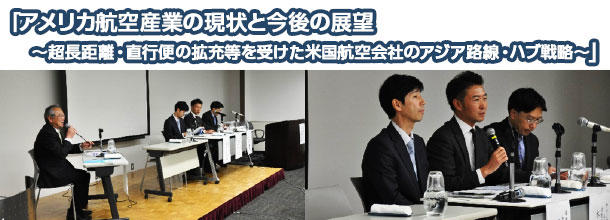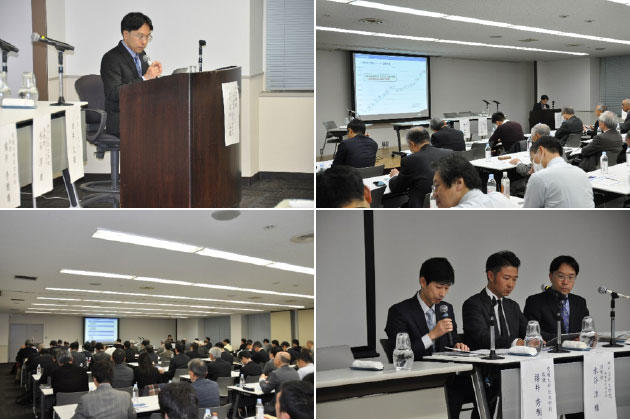Current Status and Future Outlook of U.S. Aviation Industry ~U.S. Airline Companies' Asian Routes and Hub Strategies, Considering Expanded Ultra-Long-Haul and Direct Flights~
- Aviation and Airport
Aviation Seminar


| Organizer | Japan Transport and Tourism Research Institute (JTTRI) Aviation Policy Study Group |
|---|---|
| Date / Time | Fri, Nov 30,2018 18:30~20:30 |
| Venue | 7F Conference Room, Koku-Kaikan |
| Theme | “Current Status and Future Outlook of U.S. Aviation Industry ~U.S. Airline Companies' Asian Routes and Hub Strategies, Considering Expanded Ultra-Long-Haul and Direct Flights~” |
Event Summary
So far, due to geographical characteristics that Japan, especially Narita International Airport, is located at the eastern end of the Asia-Pacific region, aircraft cruising range limits, and Japan being the largest economic power in Asia, etc., U.S. airline companies set many flights to Asian countries via Japan.However, in recent years, against the background of the increase in aviation demand in Asia due to economic development in China and India, the development of large-scale airports in Asia, and the appearance of new aircraft capable of long-haul operations, U.S. airline companies are expanding the operations of long-haul and direct flights, etc. As a result, the positioning of flights Japan-U.S. routes and going to Asian countries via Japan has been changed, and it seems that the expansion of direct flights from the U.S. to Asia are accelerating.
In 2018, the A350-900ULR, an ultra-long-haul, new-type aircraft with a cruising capability of about 18,000 km, which is close to the half-orbit of the earth, was introduced, and the world's longest route, New York-Singapore route was launched. From now on, as the environment surrounding international aviation between the U.S. and Asia changes drastically such as expansion of airport infrastructure at large-scale airports in Asia such as Beijing Second Airport scheduled to open in 2019, and the reversal of the scale of the U.S. aviation market and the China aviation market, which is expected to be around 2025, further competition is expected to intensify among airlines.
After understanding the current situation, such as transitions in the direct flights to Asia by U.S. airline companies, the development of large-scale airports in Asia and intensifying competition between airports, the expansion of ultra-long-haul and direct flights due to development of ultra-long-haul and new aircraft, and Asia’s routes and hub strategies by three major U.S. network carriers, we discussed the future of the aviation industry in the U.S. and Japan, while clarifying future issues.
The first part of the presentation was based on surveys and analyses conducted by Japan International Transport Institute, USA (JITI), an overseas base of JTTRI, in the first half, “Trends of Passenger Airline Companies in the US,” which were conducted annually by fixed point observation, and in the second half, it was presented on the theme of “ the U.S. Airline Companies’ Asian Routes and Hub Strategies in Response to the Expansion of Ultra-Long-Haul and Direct Flights,” and the following points were presented as future perspectives and directions.
- It is necessary to overcome the competition with neighboring Asian countries in order to promote economic exchange between North America and Asia, realize a tourism-oriented country such as attracting foreign tourists, and promote regional development by activating airports. It seems that the growth of Incheon Airport as a transit airport is slowing down, and Chinese airports may be the true competitor in the future.
- With the increase in direct flights, the so-called "Passing Phenomenon" is not a unique problem in Japan. The "Passing Phenomenon" may accelerate at airports in East Asia, the Middle East, etc., where high economic growth cannot be expected in the hinterland metropolitan area, and dependence on transit passengers is high.
- According to the 2037 Air Traffic Demand Forecast, the number of air passengers between the United States and Asia is expected to remain at the top of Japan-U.S. routes, It may be necessary to continue to attach importance to Japan-U.S. routes and sustain stable growth.
- The demand for air travel between China and Asian countries is remarkable, and especially for Japan-China routes, the growth rate is expected to be very high, and it seems that measures to further promote the expansion of Japan-China routes are very important. It is also important to develop routes between Japan and Asian countries such as Southeast Asia and India.
- The following are possible future directions for the Japanese aviation industry.
- ① Promotion of Tokyo metropolitan area hub airport strategy
・At Narita International Airport and Haneda International Airport, we aim to maximize the aviation function as a metropolitan area airport by making the most of the characteristics of both airports.
・With the reduction of the air route between Tokyo and Osaka, which is expected in the opening of the Linear Chuo Shinkansen between Tokyo and Osaka (scheduled for the earliest 2037), we will aim to strengthen international routes.
②Strengthening the functions of base and regional airports・Strengthen gateway functions at Kansai Airport, Chubu Airport, Fukuoka Airport, Naha Airport, New Chitose Airport, and local airports (addition / expansion of airport facilities, introduction of innovative immigration / security inspections, enhancement of secondary transportation, etc.)
・Promote the operation of LCCs at base airports and regional airports.
③Expansion of direct flights・Promote further network strengthening for Japan-U.S. routes, Japan-China routes, and Japan-India routes.
・In particular, it is important for the FSC to expand long-haul and direct flights to and from Japan in order to avoid the exhaustion battle on the short- and middle-haul routes where the LCC is emerging.
・From the viewpoint of "Arctic route", shouldn't we consider long-distance direct flights? ・Is it possible to consider developing new destinations for ultra-long-haul, direct flights (12,000 km or more) using new aircraft?
④Capturing transit demand
・It is important to capture aviation demand in Asia, which is expected to grow, and aim to expand aviation networks inland China, Southeast Asia, etc.
・Promote the convenience and comfort of transit, such as facilitating the transit process.
⑤Further promotion of aviation liberalization and securing of fair competition
・In the field of international aviation, it may be necessary to further liberalize aviation, such as opening the “the 5th freedom” (currently limited) at Narita International Airport.
・Isn't it necessary to consider a policy for ensuring fair competition by referring to the Trump administration's policy on Middle East airlines?
⑥Cooperation with inbound measures, etc.
・In order to achieve the target of attracting foreign visitors to Japan (2020: 40 million people, 2030: 60 million people), promote new international flights and increase flights on international routes, which are expected to increase demand, in cooperation with inbound measures (creation of new inbound demand in Europe and the United States by launching long-haul LCC (10,000km class) service to North America and Europe ).
・A well-balanced development of both inbound and outbound is important, and it should be aimed at stimulating the demand for Japanese overseas travel and promoting outbound.
As the second part, a panel discussion was held and the following various issues were discussed.
- Regarding ultra-long-haul and direct flights, there may be many uncertainties at present due to the burden on passengers, cost constraints, and crew problems.
- As for ultra-long distance and direct flights, it is difficult to think of where to fly to / from Japan, so it may be important to acquire transit passengers. On the other hand, it is considered to be a great advantage for Australian airline companies operating the Kangaroo route.
- For Japanese airline companies, separating FSC and LCC brands as much as possible and thoroughly segregating them will increase profits.
- On international routes, it is important to increase the frequency of arrivals and departures of flights, and to shorten the connecting time.
- At Narita International Airport, due to opening the limited “the 5th freedom” at present, it is possible to expect the development of routes with the beyond right and the launch of long-haul LCCs that use the same airport as a transit point.
- At Haneda International Airport, isn't it important to consider the direction of the open sky?
- The number of joint ventures (JVs) is increasing in the cooperation of airline companies, which means that rivals are halved, and there is a need for more competition among airline companies.
- Regarding outbound, the situation has been flat and it may be difficult to increase it in consideration of future population decline. On the other hand, if the connection between Narita International Airport and local airports, and between Kansai International Airport and local airports improves, outbound may increase.
- For Narita international Airport, open sky to China and for Haneda International Airport, open sky + liberalization of slots will be able to bring out the full potential of each airport.
Participants
Number of participants : 180
Program of the seminar is as the following
| The First Part: Presentation |
Hiroki Sakamoto |
|---|---|
| The Second Part:Panel Discussion |
Moderator |
Outline of the seminar



